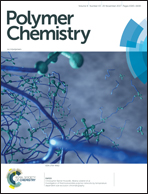Design, synthesis and ring-opening polymerization of a new iodinated carbonate monomer: a universal route towards ultrahigh radiopaque aliphatic polycarbonates†
Abstract
In order to develop a methodology of synthesizing a family of radiopaque biodegradable polymers, a new iodinated trimethylene carbonate monomer, 5,5-bis(iodomethyl)-1,3-dioxan-2-one (ITMC), was designed and synthesized from a commercially available 2,2-bis(bromomethyl)-1,3-propanediol by halogen exchange with sodium iodine followed by cyclization with ethyl chloroformate using triethylamine as an acid binding agent. The multigram-scale production of the ITMC monomer was facilely fulfilled and the good stability of the ITMC monomer allowed convenient storage under room temperature conditions. The ring-opening copolymerization of ITMC with other common monomers was successfully carried out in the presence of a small molecule initiator or macro-initiator using diphenyl phosphate as the catalyst. The physico-chemical and thermal properties of the generated aliphatic polycarbonates were measured by 1H NMR, GPC, DSC and TGA. Their radiopacity was assessed by both in vitro and ex vivo tests, and appeared high enough to be of interest for biomedical applications. Considering the good repeatability and versatility of polymerization, ITMC is a very promising carbonate monomer to synthesize various aliphatic polycarbonates with strong and adjustable radiopacity. This methodology opens an appealing way to develop a variety of radiopaque polymers by direct transformation of the iodide group.



 Please wait while we load your content...
Please wait while we load your content...